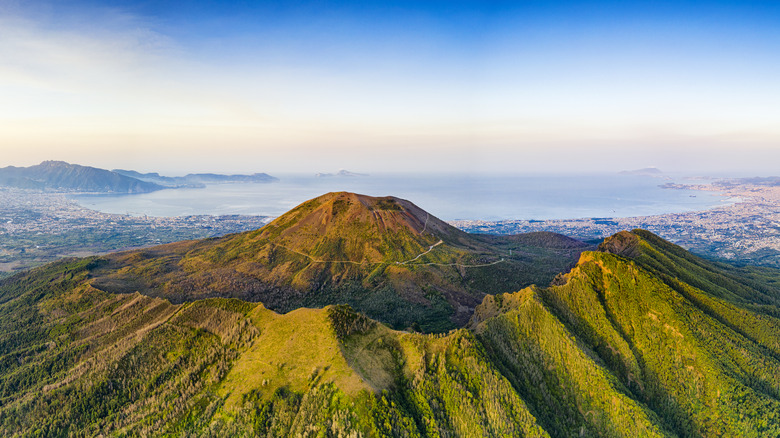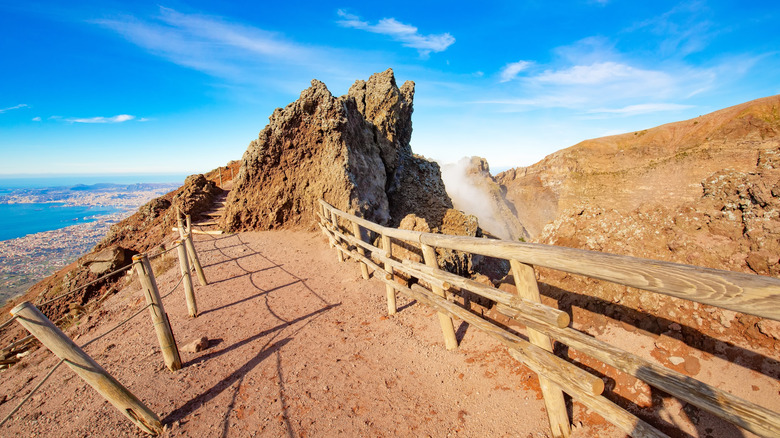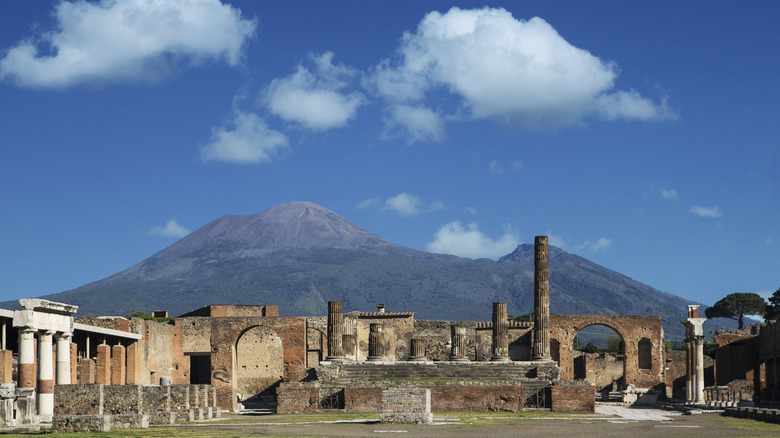Trek Around One Of Italy's Most Iconic Volcanoes For Unmatched Views And Adventure
Many are familiar with the story of Mount Vesuvius' explosive introduction into history in 79 A.D., and if not, what volcanic rock have you been living under? Towering over the Gulf of Naples, this still-active volcano has been responsible for numerous tragedies. The most famous and well known is most likely when it spewed molten lava all over the towns of Pompeii and Herculaneum, leaving behind the ashen remains of an estimated 16,000 people and their homes. This violent detonation pushed the coastline back several miles while also destroying the volcano top itself. In fact, it is widely believed that the mountain was much higher than its 4,200 feet today. The last recorded eruption here was as recent as 1944, and though it has not erupted since then, it can at any time.
So, why visit an active volcano? Well, for starters, the views! From the top, visitors can take in panoramic views of Naples, its bay, Pompeii, and the nearby mountains. Stand atop the crater rim and stare directly into the seemingly bottomless blackened and smoky depths. For visitors to Naples or the Amalfi Coast, a morning spent hiking Mount Vesuvius should be combined with a trip to Pompeii, after all, you will be climbing to the top of the very volcano that caused its demise, so why not learn a bit about it?
Hiking Mount Vesuvius
Before heading off on an adventure worthy of Indiana Jones, here are a few things to know about hiking the area. From 2001 to 2003, the Vesuvius National Park created 11 new paths for hikers to enjoy. However, the most popular one is the Gran Cono Trail, a 2.4-mile hike that leads to the rim of the volcano. Although considered to be more of a walk than a hike, the elevation difference may cause breathing issues. Visitors should plan on spending 1.5 to two hours, which will allow you ample time to take photos, enjoy the views, and complete the walk. While most tourists travel to Italy during the sunnier seasons, this region gets particularly toasty in summer, so it's best to avoid hiking unless your visit is during a more temperate month.
While guided tours are available, hiking Mount Vesuvius doesn't require you to book one. In fact, if you'd like to learn more about the volcano, included with your ticket is a short 15-minute tour that departs regularly from the guide shelter next to the souvenir shop near the rim of the crater. As far as clothing preparation goes, make sure you wear some sturdy shoes because you will be walking up and down dusty, unstable surfaces. This means leaving the sandals at home, unfortunately. Bring a hat, sunscreen, and water, and if you'll be traveling during winter, a light jacket.
How to get there
Although a visit to Mount Vesuvius requires a bit of planning, it is simple enough to access via public transportation. From Naples, Mount Vesuvius is easily accessible via the Circumvesuviana train. The train departs from the underground terminal beneath the Naples Central train station in Piazza Garibaldi. Make sure to get on the train marked Sorrento-Pompeii. From the Circumvesuviana Pompei Villa dei Misteri station, visitors can take an Ente Autonomo Volturno (EAV) bus to the trailhead on Mount Vesuvius, and walk up to the crater. Or, from the Circumvesuviana Ercolano station, visitors can take the Vesuvio Express shuttle.
Travelers can also reach Vesuvius by car, though parking is limited. The official parking area is a little less than a mile from the ticket office, which you can reach by either walking or taking a shuttle bus. If parking is unavailable in the parking lot, you can park on the street heading up toward the volcano, but be aware that it is narrow. Tickets are only available for purchase online, not at the gate, and entries are timed. Book in advance to guarantee your spot, especially if your visit is during the high seasons. So, do you dare climb to the top of one of the most dangerous volcanoes in the world?


